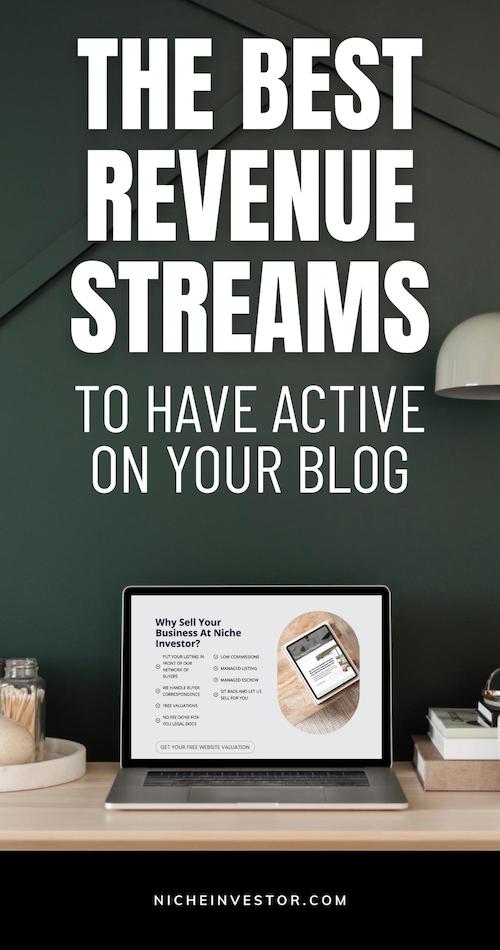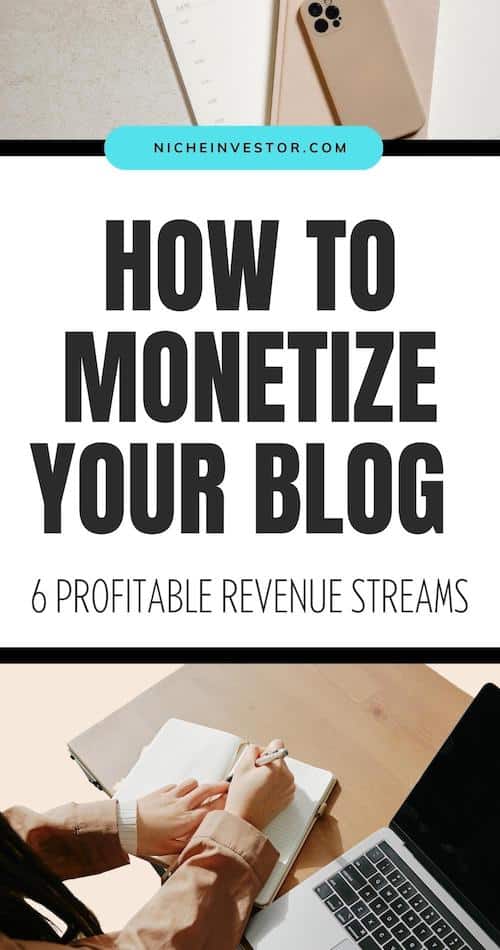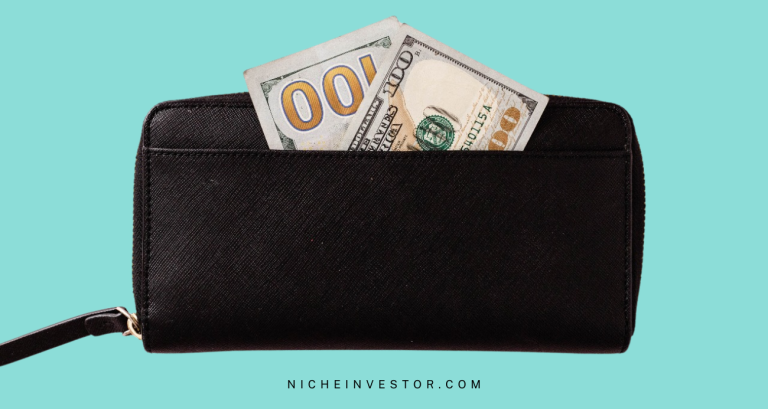How To Monetize Your Blog: 6 Most Profitable Revenue Streams

Making money from your blog might seem like a difficult feat to take on, but it is actually much easier than it sounds!
There are so many ways to earn revenue from websites when you know how to monetize your blog correctly. I have tons of resources to help you learn all about them.
The first step is deciding which monetization strategy is right for your business.
Keep reading to learn more about 6 different monetization strategies and decide which ones could be best for you and your blog!
As an affiliate partner of various brands and sponsored content, we may earn commission on qualifying purchases. Disclaimer | Advertise With Us

How To Monetize Your Blog: 6 Most Profitable Revenue Streams
1. Ad Revenue
Monetizing your blog through ads is a great way to start making money when your blog is starting to get its footing.
You can use a strategy called a “direct deal” where you, as the business owner, contact companies to display their ads on your blog. These companies will pay you to post their advertisements on your website if your content matches with their business.
If you are just starting out and don’t know too much about displaying ads, you can work with an ad network to sell ad space on your behalf.
Using an ad network takes away the pressure of keeping up with the advertisements. A really popular ad network is Google Adsense.
Adsense works behind the scenes for your website by following along with your posts and displaying relevant advertisements.
For example, if you make a blog post about new beauty products you’ve tried, Adsense might display an ad about a beauty subscription box or a makeup company.
Premium ad networks: Mediavine
Different ad networks pay differently. Premium networks like Mediavine and Monumetric typically pay more than Adsense.
Mediavine provides bloggers with full-service ad management.
The goal of Mediavine is to do all of the behind-the-scenes work for your website so you can focus on creating content and staying focused on what you love! They are also advocates for diversity, equity and inclusion so they seek out other brands that promote the same values.
Not only does Mediavine provide you with ad management, but also programmatic advertising and influencer marketing.
Programmatic advertising with Mediavine connects you with thousands of advertising partners so you don’t have to worry about finding companies that align with your niche.
Joining Mediavine connects you to a team that provides around-the-clock support to help you grow your business.
2. Affiliate Links
Affiliate marketing is when you use another company’s product or service link on your blog and if a user makes a purchase using that link you receive a commission.
Essentially this makes you an ambassador for a company.
This is a great monetization strategy for blogs that make product or service recommendations and have an engaged audience looking to make purchases.
Some blog niches that would work with this are lifestyle, travel, informational or how-to blogs.
An example of how this may work if you own a lifestyle blog could be:
Say you make a post about healthy eating. In your blog post, you can make a recommendation to start a membership with a food subscription box service to make cooking healthy meals at home easier.
With this recommendation, you would insert a link to the food subscription box website that they provide you, and if your reader makes a purchase with that link you receive a commission.
It is always best to be transparent with your users if you are using affiliate links because it maintains trust with your customer base.
There may also be legal requirements enforced in your country regarding the use of affiliate links. For example, in the US, the Federal Trade Commission (FTC) requires you to be transparent when receiving an endorsement.
So, which type of affiliate marketing is right for you?
a) High-Paying, Low-Volume
This type of affiliate program is best for niche blogs that have a dedicated base of very specific customers.
Additionally, there tends to be higher levels of competition when it comes to high-paying affiliate programs. So, this is a better direction for established blogs.
b) Low-Paying, High-Volume
This type of affiliate program is best for more general blogs with high volumes of traffic. With this, you will receive less commission on the purchase of your link but it is more likely to get clicks with this.
For example, there are affiliate programs like Amazon Associates where you can earn up to 10% on almost anything that Amazon sells with your link. But it’s worth it to work with higher-commission programs like these.
3. Digital Products
A benefit of selling digital products is not needing to store your physical inventory or outsource for your products. It saves tons of time and money!
Additionally, digital products are infinitely scalable. Meaning you have no limits on how much of your product you can sell.
This eventually leads to high profit margins and lots of opportunities to grow and promote your business.
So, what can you sell? If you run a travel blog, think about selling an online travel guide for specific destinations or checklists for trip preparation.
If you’re an artist you can sell digital prints of your art, logos, fonts or animations. If you’re a photographer consider selling your presets for photos and videos!
Like I said before… tons of opportunities!
Start by brainstorming some ideas of digital products that you can sell. Ask yourself things like:
- What knowledge do I have to share?
- What am I most passionate about?
- Do I offer something now that I can begin to monetize?
- Can I create digital products of already physical products?
Once you’ve brainstormed all that you can, it’s time to get to work! Create your digital product and set up your online marketplace.
4. Ecommerce
eCommerce has been around for nearly three decades and is defined as commercial transactions conducted electronically on the Internet. Some really popular eCommerce websites are Amazon and eBay.
An eCommerce website can sell physical goods, services, and digital products or have a dropshipping style.
Dropshipping is when the website holds no inventory and sells goods to its customers through other suppliers instead.
Running an eCommerce website is not easy by any means and takes a lot of time and hard work. Just because you are selling products or services on your website does not mean that you have an automatic audience. So, this is where the blog comes in.
Having a blog attached to your eCommerce website can help boost your audience through things like search engine optimization, engagement, conversion rates and building a community for your brand.
For example, if you own a gym and also sell weight-loss programs, your blog could be success stories from your clients and tips for a healthy lifestyle.
The additional benefit to this is also creating more content on your website which boosts your link up on search engines for potential customers.
5. Sponsored Posts
A sponsored blog post is a post that a brand or company will pay you to write for your website. This revenue stream is also referred to as influencer marketing.
But you do NOT need to be a big influencer with a million followers. In fact, brands often love working with creators who have under 5,000 followers, so long as its an engaged audience.
Even with niche sites, you can commonly find companies that are happy to partner with your blog.
The best way to get sponsored posts is to proactively seek them out and have content ready to provide.
Start by creating a media kit to help you pitch to a brand that you want to work with.
When setting up your media kit, it should contain your name, contact, blog name & URL, social media handles & follower counts, statistics from Google Analytics and a description of your offer.
Learn more about what to include in a blog media kit.
Not to forget that it should also fit the aesthetic of your website and look clean, creative, and professional.
Think about reaching out for product reviews, product recommendations or a review post about the company as a whole. Sometimes the brand will even provide you with some of the content to write!
Sponsored posts are a great way to monetize your blog and increase your traffic from the partners’ brand.
There are also a lot of companies that are looking to specifically use this tactic as a form of marketing.
Influencer marketing helps connect your blog to brands and influencers that help you deliver engaging and quality content to your audience. They are there to help your business grow and prosper!
6. Subscriptions
Another way to monetize your blog is to create a subscription fee for your audience to pay in order to view your content.
Typically, businesses will charge a monthly or annual fixed fee.
This sets up a continuous cash flow for your website which has the potential to allow for a more steady and predictable revenue.
Having a subscription to your blog does not mean that you have to require membership for all of your content. You can set it up so that those with a subscription have access to premium content, educational courses or extra services.
For example, at HerPaperRoute we have free training on our blog and newsletter for all users to access, and a paid, private subscription membership for those who would like enrollment in our courses, mastermind access and early access to special offers.
Combining aspects of a subscription has been very beneficial to HerPaperRoute and could be for your website as well!
How To Monetize Your Blog: 6 Most Profitable Revenue Streams – Conclusion
As you can see, there are so many ways to monetize your blog. And you don’t have to use just one!
In fact, it’s recommended that you monetize your blog with two or more of these revenue streams. Don’t depend on only one income stream.
Plus, when you are ready to sell your blog, buyers will like to see that there are multiple sources of income in effect.
I hope that you have found this post as a helpful resource and feel more confident in monetization strategies for your blog.
To stay up to date when we have new blog listings here at Niche Investor, make sure you sign up for our weekly deal maker newsletter.
Lastly, if you are interested in how to monetize your blog, read: Real examples of how much blogs earn. That article showcases real websites that sold at Niche Investor, and shows how much income and traffic they had when they sold.
Next, read up on how to actually buy a blog.









